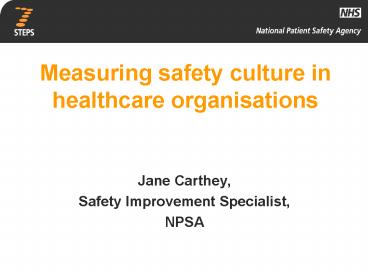Measuring safety culture in healthcare organisations - PowerPoint PPT Presentation
1 / 21
Title:
Measuring safety culture in healthcare organisations
Description:
To highlight differences in perceptions between staff groups in the organisation ... any specific intervention to change the safety culture of your organisation ... – PowerPoint PPT presentation
Number of Views:89
Avg rating:3.0/5.0
Title: Measuring safety culture in healthcare organisations
1
Measuring safety culture in healthcare
organisations
- Jane Carthey,
- Safety Improvement Specialist,
- NPSA
2
NPSA Seven Steps to Patient Safety
- Step One Build a safety culture
- A safety culture is.
- A culture where staff have a constant and active
awareness of the potential for things to go wrong - A culture that is open and fair, and one that
encourages people to speak up about mistakes
3
Other definitions
- The shared beliefs and values of staff working in
an organisation that determine the commitment to
and quality of an organisations health and
safety management - Alternatively.
- The way we do things around here
- Safety culture manifests itself in all safety
related aspects of the organisation
4
- Culture Oh No, not the C word!
- "When I hear the word 'culture' . . . I release
the safety-catch of my Browning." - HANNS JOHST,
Schlageter - "Culture is an instrument wielded by professors
to manufacture professors, who when their turn
comes will manufacture professors." - SIMONE
WEIL, The Need for Roots
5
Manchester Patient Safety Framework
- Originally developed for use in primary care
- Tailored from a tool developed for the oil
industry and used by Shell plc. - Based on Westrums (1993) theory of
organisational safety - Tailoring the tool for use in acute, mental
health, ambulance settings
6
Levels of maturity with respect to a safety
culture
Risk management is an integral part of everything
that we do
We are always on the alert for risks that might
emerge
We have systems in place to manage all like risks
We do something when we have an incident
Why waste our time on safety?
Reactive
Pathological
Calculative
Proactive
Generative
7
Pathological
Reactive
Calculative
Proactive
Generative
Commitment to Q
Priority to PS
Causes
Investigation
Learning
Communication
Personnel
Education
Team working
8
Pathological
Incidents are seen as bad luck and outside the
organisations control, occurring as a result of
staff errors or patient behaviour. Ad hoc
reporting systems are in place but the
organisation is largely in blissful ignorance
unless serious events occur or solicitors
letters are received. Incidents and complaints
are swept under the carpet if possible. There is
a high blame culture with individuals subjected
to victimisation and disciplinary action
Perceptions of causes of adverse events and near
misses and their identification
9
Generative
Organisational failures are noted, although staff
are also aware of their own professional
accountability in relation to errors. It is
second nature for staff to report adverse events
and near misses, as they have confidence in the
investigation process and understand the value of
reporting. Integrated systems allow adverse
events, near misses, complaints and litigation
cases to be analysed together. Staff, patients
and relatives are actively supported from the
time of the incident. The organisation has a high
level of openness and trust.
Perceptions of causes of adverse events and near
misses and their identification
10
What can MaPSaF be used for?
- To facilitate self-reflection on the safety
culture maturity of your healthcare organisation - To promote recognition that patient safety is a
complex multidimensional concept - To stimulate discussion about areas of strength
and weakness in your patient safety culture - To highlight differences in perceptions between
staff groups in the organisation - To help understand how the organisation with a
more mature safety culture might look. - To help evaluate any specific intervention to
change the safety culture of your organisation
11
Examples of using MaPSaF 1
- A team leader wants his/her team to recognise the
relevance and importance of patient safety
culture in their daily working lives - Use MaPSaF to introduce the concept of safety
culture to the team and facilitate discussion
about where any problems lie and how things can
be improved
12
Examples of using MaPSaF 2
- An operational management team wants to know more
about the strengths and weaknesses of the patient
safety culture in their trust - Use MaPSaF at a regular meeting to facilitate
their discussion and identify how to improve the
safety culture
13
What is MaPSaF not for?
- MaPSaF is NOT designed to be used
- For performance management and assessment
purposes - To apportion blame if using it indicates that the
organisations safety culture is not
significantly mature
14
How its used
- Focus groups
- Identify different perceptions between staff
groups - Discuss differences
- Develop action plan
15
Tailoring of the tool
- Six focus groups
- Took 3 risk dimensions
- Language appropriate to care setting?
- How they would use MAPSAF
- Approved changes
16
Piloting MaPSaF versions
- 4 pilots carried out
- Mental health, acute, primary care, ambulance
trust - Process of using the framework
- Feedback to team on changes
- Final amendments now being made
17
Roll out
- NPSA to roll out later in 2005
- Along with guidance on how to use
- Web site to feedback findings
18
A final thought 2005 Indianapolis grand prix
7 teams refused to race and returned to the pit
lane after the parade lap due to safety concerns
with their Michelin tyres
19
Only those teams using Bridgestone tyres took
part in the race much to the annoyance of
the fans
20
The effects of the incident
- Huge reputation damage to F1
- Huge losses expected in TV revenue and
sponsorship - BUT
- A rare victory for safety resulting from a
proactive response to an identified hazard. - Work towards achieving a similar culture in the
NHS
21
- Thank you for listening
- Any questions?
- www.npsa.nhs.uk

